The Effects of Lycopene and Insulin on Histological Changes and the Expression Level of Bcl-2 Family Genes in the Hippocampus of Streptozotocin-Induced Diabetic Rats
- PMID: 28656152
- PMCID: PMC5471551
- DOI: 10.1155/2017/4650939
The Effects of Lycopene and Insulin on Histological Changes and the Expression Level of Bcl-2 Family Genes in the Hippocampus of Streptozotocin-Induced Diabetic Rats
Abstract
The aim of this study was to evaluate the effects of antioxidants lycopene and insulin on histological changes and expression of Bcl-2 family genes in the hippocampus of streptozotocin-induced type 1 diabetic rats. Forty-eight Wistar rats were divided into six groups of control (C), control treated with lycopene (CL), diabetic (D), diabetic treated with insulin (DI), diabetic treated with lycopene (DL), and diabetic treated with insulin and lycopene (DIL). Diabetes was induced by an injection of streptozotocin (60 mg/kg, IP), lycopene (4 mg/kg/day) was given to the lycopene treated groups as gavages, and insulin (Sc, 1-2 U/kg/day) was injected to the groups treated with insulin. The number of hippocampus neurons undergoing cell death in group D had significant differences with groups C and DIL (p < 0.001). Furthermore, insulin and lycopene alone or together reduced the expression of Bax, but increased Bcl-2 and Bcl-xL levels in DI, DL, and DIL rats, especially when compared to group D (p < 0.001). The ratios of Bax/Bcl-2 and Bax/Bcl-xL in DI, DL, and DIL rats were also reduced (p < 0.001). Our results indicate that treatment with insulin and/or lycopene contribute to the prevention of cell death by reducing the expression of proapoptotic genes and increasing the expression of antiapoptotic genes in the hippocampus.
Figures



Similar articles
-
Lycopene counteracts the hepatic response to 7,12-dimethylbenz[a]anthracene by altering the expression of Bax, Bcl-2, caspases, and oxidative stress biomarkers.Pharm Biol. 2012 Dec;50(12):1513-8. doi: 10.3109/13880209.2012.688057. Epub 2012 Sep 14. Pharm Biol. 2012. PMID: 22978712
-
Evaluation of insulin and ascorbic acid effects on expression of Bcl-2 family proteins and caspase-3 activity in hippocampus of STZ-induced diabetic rats.Cell Mol Neurobiol. 2009 Feb;29(1):133-40. doi: 10.1007/s10571-008-9305-y. Epub 2008 Aug 30. Cell Mol Neurobiol. 2009. PMID: 18758938 Free PMC article.
-
Changes in the Pancreas in Experimental Diabetes and the Effect of Lycopene on These Changes: Proliferating, Apoptotic, and Estrogen Receptor α Positive Cells.Anat Rec (Hoboken). 2017 Nov;300(11):2000-2007. doi: 10.1002/ar.23641. Epub 2017 Jul 17. Anat Rec (Hoboken). 2017. PMID: 28681493
-
Grape seed extract has superior beneficial effects than vitamin E on oxidative stress and apoptosis in the hippocampus of streptozotocin induced diabetic rats.Gene. 2015 Jan 25;555(2):119-26. doi: 10.1016/j.gene.2014.10.052. Epub 2014 Oct 30. Gene. 2015. PMID: 25445279
-
Lycopene attenuates endothelial dysfunction in streptozotocin-induced diabetic rats by reducing oxidative stress.Pharm Biol. 2011 Nov;49(11):1144-9. doi: 10.3109/13880209.2011.574707. Epub 2011 Apr 26. Pharm Biol. 2011. PMID: 21517710
Cited by
-
Lycopene Modulates Pathophysiological Processes of Non-Alcoholic Fatty Liver Disease in Obese Rats.Antioxidants (Basel). 2019 Aug 5;8(8):276. doi: 10.3390/antiox8080276. Antioxidants (Basel). 2019. PMID: 31387231 Free PMC article.
-
Total Flavonoids from Oroxylum indicum Induce Apoptosis via PI3K/Akt/PTEN Signaling Pathway in Liver Cancer.Evid Based Complement Alternat Med. 2018 Feb 15;2018:3021476. doi: 10.1155/2018/3021476. eCollection 2018. Evid Based Complement Alternat Med. 2018. PMID: 29636773 Free PMC article.
-
Lycopene as a Natural Antioxidant Used to Prevent Human Health Disorders.Antioxidants (Basel). 2020 Aug 4;9(8):706. doi: 10.3390/antiox9080706. Antioxidants (Basel). 2020. PMID: 32759751 Free PMC article. Review.
-
Effect of induced diabetes on morphometric indexes of the cerebellar cortex and gene expression in C57BL mice.Iran J Basic Med Sci. 2023;26(12):1444-1448. doi: 10.22038/IJBMS.2023.71172.15457. Iran J Basic Med Sci. 2023. PMID: 37970442 Free PMC article.
-
Lycopene: A Potent Antioxidant with Multiple Health Benefits.J Nutr Metab. 2024 Jun 8;2024:6252426. doi: 10.1155/2024/6252426. eCollection 2024. J Nutr Metab. 2024. PMID: 38883868 Free PMC article. Review.
References
-
- Gavin J. R., III, Alberti K., Davidson M. B., DeFronzo R. A. Report of the expert committee on the diagnosis and classification of diabetes mellitus. Diabetes Care. 1997;20:p. 1183. - PubMed
-
- Rice-Evans C., Miller N., Paganga G. Antioxidant properties of phenolic compounds. Trends in Plant Science. 1997;2:152–159. doi: 10.1016/S1360-1385(97)01018-2. - DOI
-
- Patil C. S., Singh V. P., Kulkarni S. K. Modulatory effect of sildenafil in diabetes and electroconvulsive shock-induced cognitive dysfunction in rats. Pharmacological Reports. 2006;58:p. 373. - PubMed
MeSH terms
Substances
LinkOut - more resources
Full Text Sources
Other Literature Sources
Medical
Research Materials

